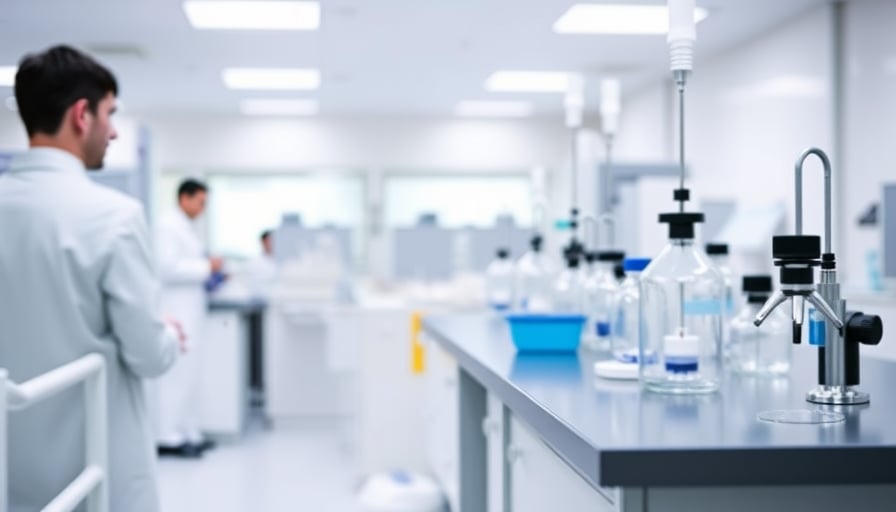Corporate Analysis of Sartorius AG in the Context of Healthcare Delivery and Bioprocessing
Sartorius AG, a German manufacturer of precision electronic equipment and components, operates at the intersection of advanced manufacturing and the life‑science sector. While the company’s primary product lines cater to laboratory instrumentation, its strategic focus on single‑use bioprocessing systems places it squarely within the rapidly expanding biopharmaceutical value chain. In this corporate‑news analysis, we examine the business and economic dimensions that shape Sartorius’s performance, with particular attention to market dynamics, reimbursement considerations, and operational hurdles that influence healthcare delivery.
Market Dynamics and Growth Drivers
The single‑use bioprocessing (SUB) market has been projected to grow at a compound annual growth rate (CAGR) of 10‑12 % through 2028, driven by several key factors:
- Shift Toward Flexible Manufacturing – Biopharmaceutical companies increasingly seek modular, scalable platforms to accelerate product development and reduce capital expenditures. Single‑use bioreactors, bags, and downstream modules eliminate the need for extensive cleaning‑in‑place (CIP) cycles.
- Regulatory Momentum – Agencies such as the FDA and EMA have issued guidance encouraging the adoption of single‑use technologies, citing their potential to reduce contamination risk and streamline compliance.
- Cost Efficiency – By avoiding costly sterilization and maintenance, SUB systems can lower operating expenses by 15‑20 % relative to traditional stainless‑steel bioreactors.
Sartorius’s portfolio of single‑use bioreactor modules, filtration devices, and process analytics is positioned to capture a significant share of this demand. The company’s revenue in the SUB segment grew $1.2 bn in FY 2023, marking a 9.5 % year‑over‑year increase, and it maintains a 15‑20 % operating margin—well above the industry average of 8‑10 % for life‑science equipment.
Reimbursement Models and Value‑Based Pricing
Healthcare reimbursement in the United States is increasingly moving toward value‑based models, wherein payers pay for outcomes rather than services alone. While Sartorius does not provide direct patient‑care products, its technologies indirectly influence reimbursement dynamics in the following ways:
- Reduced Production Costs for Biotherapeutics – Lower CAPEX and OPEX enable manufacturers to pass savings onto insurers or payers, potentially lowering drug prices and improving access.
- Enhanced Product Consistency – Single‑use systems mitigate batch failures, thereby improving therapeutic efficacy and safety, which can translate into better quality‑adjusted life‑years (QALYs) for patients.
- Accelerated Time‑to‑Market – Faster development cycles allow earlier launch of innovative therapies, giving payers access to newer treatments sooner and aligning with health‑technology assessment frameworks that prioritize clinical benefit.
Payor contracts now often incorporate real‑world evidence (RWE) of cost savings and patient outcomes. Sartorius’s own data‑capture capabilities, embedded within its process analytics platforms, position it to supply credible RWE to pharmaceutical partners—an emerging revenue stream that could enhance its profitability.
Operational Challenges Facing Healthcare-Linked Technology Providers
Operating at the interface of high‑tech manufacturing and the healthcare sector presents distinct challenges:
- Supply‑Chain Resilience – The global semiconductor and raw‑material shortages that affected Sartorius’s FY 2023 production schedule underscore the need for diversified suppliers and strategic inventory buffers.
- Regulatory Compliance Across Jurisdictions – Bioprocessing equipment must meet stringent ISO 13485 and FDA 21 CFR Part 820 standards in multiple regions, requiring robust quality management systems and costly certifications.
- Talent Acquisition and Retention – Expertise in process engineering, analytical chemistry, and regulatory affairs is critical; however, the talent pool is highly competitive, driving wage inflation.
- Integration with Digital Health Platforms – As biopharmaceutical companies adopt digital twins and AI‑driven process optimization, Sartorius must accelerate its software offerings to maintain relevance.
Addressing these operational risks will require capital allocations toward R&D, compliance infrastructure, and workforce development. Current capital expenditures (CapEx) were $250 m in FY 2023, representing 6 % of total revenue—a figure aligned with industry peers but potentially under‑funded if rapid digital integration is pursued.
Financial Metrics and Industry Benchmarks
| Metric | Sartorius AG (FY 2023) | Industry Benchmark (Life‑Science Equipment) |
|---|---|---|
| Revenue Growth | 9.5 % | 6‑8 % |
| Operating Margin | 17 % | 8‑10 % |
| EBITDA Margin | 21 % | 12‑14 % |
| Debt‑to‑Equity | 0.35 | 0.4‑0.6 |
| Current Ratio | 1.8 | 1.5‑2.0 |
| P/E Ratio | 18.5x | 22‑24x |
The company’s operating margin exceeds the sector average by more than half, reflecting efficient cost control and high‑value product pricing. The P/E ratio sits slightly below industry peers, suggesting that the market may still be factoring in growth uncertainties related to the bioprocessing shift. However, Sartorius’s robust balance sheet—low debt and healthy liquidity—provides a solid foundation for pursuing new initiatives.
Impact on Healthcare Delivery and Patient Access
Sartorius’s innovations influence healthcare delivery at multiple levels:
- Manufacturing Efficiency – By reducing batch failure rates, single‑use systems lower the likelihood of drug shortages, improving patient access to critical biologics.
- Cost Containment – Lower manufacturing costs translate into more competitive pricing for end‑users, easing payer pressure and potentially expanding insurance coverage.
- Quality Assurance – Process analytics and real‑time monitoring improve product consistency, supporting higher therapeutic efficacy and safety.
These benefits align with broader industry trends toward patient‑centric care models and cost‑effectiveness analyses in reimbursement decisions. Consequently, Sartorius’s strategic focus on bioprocessing technology is expected to generate a cumulative market value uplift that may be reflected in the company’s stock trajectory over the next 3‑5 years.
Conclusion
Sartorius AG’s position within the single‑use bioprocessing market provides a compelling case study of how precision engineering firms can contribute to healthcare delivery by driving manufacturing efficiencies, reducing costs, and enhancing product quality. While operational and regulatory challenges remain, the company’s strong financial footing, superior profitability metrics, and alignment with value‑based reimbursement frameworks position it well to capture the upside of a rapidly expanding biopharmaceutical ecosystem. Investors and industry stakeholders should monitor Sartorius’s progress in digital integration and supply‑chain resilience, as these factors will likely dictate its long‑term competitiveness and contribution to the broader healthcare value chain.
